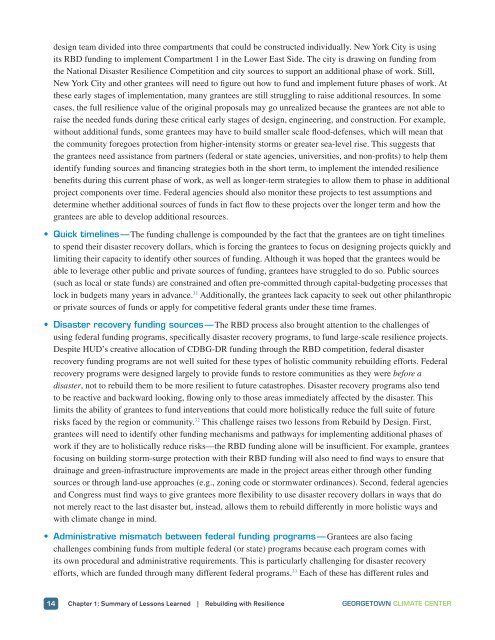Rebuilding with Resilience
dw0r306aHfX
dw0r306aHfX
You also want an ePaper? Increase the reach of your titles
YUMPU automatically turns print PDFs into web optimized ePapers that Google loves.
design team divided into three compartments that could be constructed individually. New York City is using<br />
its RBD funding to implement Compartment 1 in the Lower East Side. The city is drawing on funding from<br />
the National Disaster <strong>Resilience</strong> Competition and city sources to support an additional phase of work. Still,<br />
New York City and other grantees will need to figure out how to fund and implement future phases of work. At<br />
these early stages of implementation, many grantees are still struggling to raise additional resources. In some<br />
cases, the full resilience value of the original proposals may go unrealized because the grantees are not able to<br />
raise the needed funds during these critical early stages of design, engineering, and construction. For example,<br />
<strong>with</strong>out additional funds, some grantees may have to build smaller scale flood-defenses, which will mean that<br />
the community foregoes protection from higher-intensity storms or greater sea-level rise. This suggests that<br />
the grantees need assistance from partners (federal or state agencies, universities, and non-profits) to help them<br />
identify funding sources and financing strategies both in the short term, to implement the intended resilience<br />
benefits during this current phase of work, as well as longer-term strategies to allow them to phase in additional<br />
project components over time. Federal agencies should also monitor these projects to test assumptions and<br />
determine whether additional sources of funds in fact flow to these projects over the longer term and how the<br />
grantees are able to develop additional resources.<br />
• Quick timelines — The funding challenge is compounded by the fact that the grantees are on tight timelines<br />
to spend their disaster recovery dollars, which is forcing the grantees to focus on designing projects quickly and<br />
limiting their capacity to identify other sources of funding. Although it was hoped that the grantees would be<br />
able to leverage other public and private sources of funding, grantees have struggled to do so. Public sources<br />
(such as local or state funds) are constrained and often pre-committed through capital-budgeting processes that<br />
lock in budgets many years in advance. 31 Additionally, the grantees lack capacity to seek out other philanthropic<br />
or private sources of funds or apply for competitive federal grants under these time frames.<br />
• Disaster recovery funding sources — The RBD process also brought attention to the challenges of<br />
using federal funding programs, specifically disaster recovery programs, to fund large-scale resilience projects.<br />
Despite HUD’s creative allocation of CDBG-DR funding through the RBD competition, federal disaster<br />
recovery funding programs are not well suited for these types of holistic community rebuilding efforts. Federal<br />
recovery programs were designed largely to provide funds to restore communities as they were before a<br />
disaster, not to rebuild them to be more resilient to future catastrophes. Disaster recovery programs also tend<br />
to be reactive and backward looking, flowing only to those areas immediately affected by the disaster. This<br />
limits the ability of grantees to fund interventions that could more holistically reduce the full suite of future<br />
risks faced by the region or community. 32 This challenge raises two lessons from Rebuild by Design. First,<br />
grantees will need to identify other funding mechanisms and pathways for implementing additional phases of<br />
work if they are to holistically reduce risks—the RBD funding alone will be insufficient. For example, grantees<br />
focusing on building storm-surge protection <strong>with</strong> their RBD funding will also need to find ways to ensure that<br />
drainage and green-infrastructure improvements are made in the project areas either through other funding<br />
sources or through land-use approaches (e.g., zoning code or stormwater ordinances). Second, federal agencies<br />
and Congress must find ways to give grantees more flexibility to use disaster recovery dollars in ways that do<br />
not merely react to the last disaster but, instead, allows them to rebuild differently in more holistic ways and<br />
<strong>with</strong> climate change in mind.<br />
• Administrative mismatch between federal funding programs — Grantees are also facing<br />
challenges combining funds from multiple federal (or state) programs because each program comes <strong>with</strong><br />
its own procedural and administrative requirements. This is particularly challenging for disaster recovery<br />
efforts, which are funded through many different federal programs. 33 Each of these has different rules and<br />
14 Chapter 1: Summary of Lessons Learned | <strong>Rebuilding</strong> <strong>with</strong> <strong>Resilience</strong> GEORGETOWN CLIMATE CENTER


